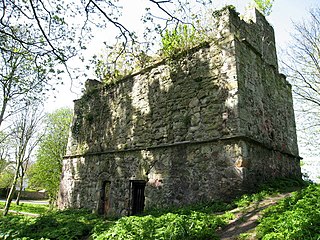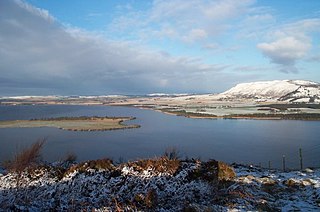Related Research Articles

The Bishop of St. Andrews was the ecclesiastical head of the Diocese of St Andrews in the Catholic Church and then, from 14 August 1472, as Archbishop of St Andrews, the Archdiocese of St Andrews.
Donald Elmslie Robertson Watt FRSE was a Scottish historian and Professor Emeritus at St Andrews University.
John Woodman [Wodman] was a 15th-century churchman based in the Kingdom of Scotland. Woodman was a canon of the diocese of St Andrews, and as such was locally made Prior of Pittenweem on the death of the previous prior, James Kennedy, Bishop of St Andrews; however, he was opposed by one Walter Monypenny, while the new bishop, Patrick Graham, desired the position for himself. Woodman had lost litigation for this post to Monypenny by 17 September 1466, and possession to the bishop, though Woodman was still claiming this priory as late as 1477 when he became Bishop of Ross.
William de Cambuslang was a 14th-century Scottish churchman, presumably coming from a family based at or originating from Cambuslang near Glasgow.
Radulf is an obscure churchman in early 13th-century Scotland, elected as Bishop of Dunblane some time between 1223 and 1225. The first of only two notices of his existence occurs in an Arbroath Abbey deed where he is styled "Radulf elect of Dunblane"; the document can be dated to 1223–1225. On 12 January 1226 Pope Honorius III instructed the Bishop of St Andrews, the Bishop of Moray and the Bishop of Caithness, to enjoin a new election for the bishopric of Dunblane, as "R. elected Bishop of Dunblane" had resigned in the Pope's presence a short time before. There are no clues as to Radulf's career after that. The Cathedral chapter of the diocese elected one Osbert in his place. Cockburn suggested Radulf was probably a Frenchman who had immigrated to Scotland, who got elected Bishop, but decided he would rather stay in Continental Europe after he travelled there for consecration, perhaps being offered a better post there.
William O. Tiron. was a late 13th-century Tironensian abbot and bishop in the Kingdom of Scotland. He appears in the extant sources for the first time on 25 April 1276; he is Abbot of Arbroath. According to the Scotichronicon, the work of the 15th-century historian Walter Bower, William's predecessor Adam de Inverlunan had died in 1275, so William probably became abbot in either that year or in 1276.
Jonathan was a churchman and prelate active in late twelfth- and early thirteenth century Strathearn, in the Kingdom of Scotland. He was the Bishop of Dunblane during the time of Gille Brigte of Strathearn, and it was during Jonathan's episcopate that Gille Brigte founded an Augustinian priory at Inchaffray.
Bernard was a Tironensian abbot, administrator and bishop active in late 13th- and early 14th-century Scotland, during the First War of Scottish Independence. He first appears in the records already established as Abbot of Kilwinning in 1296, disappearing for a decade before re-emerging as Chancellor of Scotland then Abbot of Arbroath.

Geoffrey was a 12th-century Anglo-Norman Benedictine monk and abbot. Of Anglo-Norman origin, he became monastic head of the Benedictine priory at Canterbury, before moving to Scotland to be the first Abbot of Dunfermline. As abbot he presided over the construction of the new monastery building, the immigration of English monks and settlers, and the accumulation of enough wealth to make Dunfermline Abbey the richest Benedictine monastic house in the Kingdom of Scotland.
The Archdeacon of Brechin was the only archdeacon in the diocese of Brechin, acting as a subordinate of the Bishop of Brechin. The archdeacon held the parish church of Strachan as a prebend from at least 1274.
The Archdeacon of the Isles was the only archdeacon in the diocese of the Isles, acting as a subordinate of the Bishop of the Isles. The number and names of the prebends, if any, associated with the archdeaconry in the later Middle Ages are not known. Before the break-away of the diocese of Man during the Western Schism, the archdeacons held Kirk Andreas as a prebend. The office seems to have fallen into disuse after the time of Alasdair Caimbeul, who received crown presentation to the position in 1592. It was to be revived in 1662.

James Haldenston or James Haldenstoun was an Augustinian churchman from 15th-century Scotland. Probably from somewhere in eastern Fife, Haldenston became an Augustinian at St Andrews, earned several degrees on the continent, and became prior of May before becoming prior of St Andrews, head of the wealthiest and most important religious house in Scotland.

Robert I or Robert of Nostell was a 12th-century Anglo-Norman Augustinian churchman, the first prior of St Andrews.

St. Mary's Priory, North Berwick, was a monastery of nuns in medieval East Lothian, Scotland. Founded by Donnchad I, Earl of Fife around 1150, the priory lasted for more than four centuries, declining and disappearing after the Scottish Reformation. It had been endowed by the Earls of Carrick as well as the Earls of Fife, but over time lost its dependence on these and came to be controlled by the more locally based Home family, who eventually acquired the priory's lands as a free barony.
Walter I was a 12th-century Augustinian Anglo-Norman prelate active in the kingdom of Scotland.
Thomas was an Augustinian canon and Cistercian monk in 13th-century Scotland. According to Walter Bower Thomas was sub-prior of St Andrews Cathedral Priory when he became prior of St Andrews, sometime in 1199. He appears as prior in contemporary documents for the first time on 6 June 1199.

Simon was a 13th-century Augustinian canon based in the Kingdom of Scotland.

Gregory of Brechin was a 13th-century prelate based in the Kingdom of Scotland.
John de Crannach was a 15th-century Scottish scholar, diplomat and prelate. Originating in the north-east of Lowland Scotland, he probably came from a family associated with the burgh of Aberdeen. Like many of his relatives, he flourished in the 15th-century Scottish church. After just over a decade at the University of Paris, Crannach became a servant of the then Dauphin Charles (VII).
Adam of Harcarse was a 13th-century Cistercian Abott. He served as Abbot of Newbattle between 1216 and 1219 and then Abbot of Melrose from 1219 until his death in 1245.
References
- MacQueen, John; MacQueen, Winifred; Watt, D. E. R., eds. (1995), Scotichronicon by Walter Bower, in Latin and English: Volume 3, Books V and VI, Scotichronicon by Walter Bower: New Edition in Latin and English with Notes and Indexes (General Editor D. E. R. Watt), Aberdeen: Aberdeen University Press, ISBN 1-873644-49-3
- Watt, D. E. R.; Murray, A. L., eds. (2003), Fasti Ecclesiae Scotinanae Medii Aevi ad annum 1638, The Scottish Record Society, New Series, Volume 25 (Revised ed.), Edinburgh: The Scottish Record Society, ISBN 0-902054-19-8, ISSN 0143-9448
- Watt, D. E. R.; Shead, N. F., eds. (2001), The Heads of Religious Houses in Scotland from Twelfth to Sixteenth Centuries, The Scottish Record Society, New Series, Volume 24 (Revised ed.), Edinburgh: The Scottish Record Society, ISBN 0-902054-18-X, ISSN 0143-9448